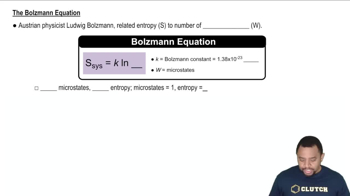Here are the essential concepts you must grasp in order to answer the question correctly.
State of a System
A state of a system refers to the macroscopic properties that define the system at a given moment, such as temperature, pressure, and volume. These properties are measurable and provide a comprehensive description of the system's overall condition. For example, a gas in a container can be described by its temperature and pressure, which together define its state.
Recommended video:
Microstate
A microstate is a specific configuration of a system at the microscopic level, detailing the exact positions and energies of all particles within the system. Each microstate corresponds to a particular arrangement of particles, and many microstates can correspond to the same macroscopic state. For instance, in a gas, the different ways in which molecules can be arranged while maintaining the same temperature and pressure represent different microstates.
Recommended video:
Statistical Mechanics
Statistical mechanics is a branch of physics that connects the microscopic properties of individual particles to the macroscopic properties of materials. It uses statistical methods to explain how the behavior of large numbers of particles leads to observable phenomena, such as temperature and pressure. This framework helps in understanding how many microstates correspond to a given state, thereby linking thermodynamics and quantum mechanics.
Recommended video:
Reaction Mechanism Overview




